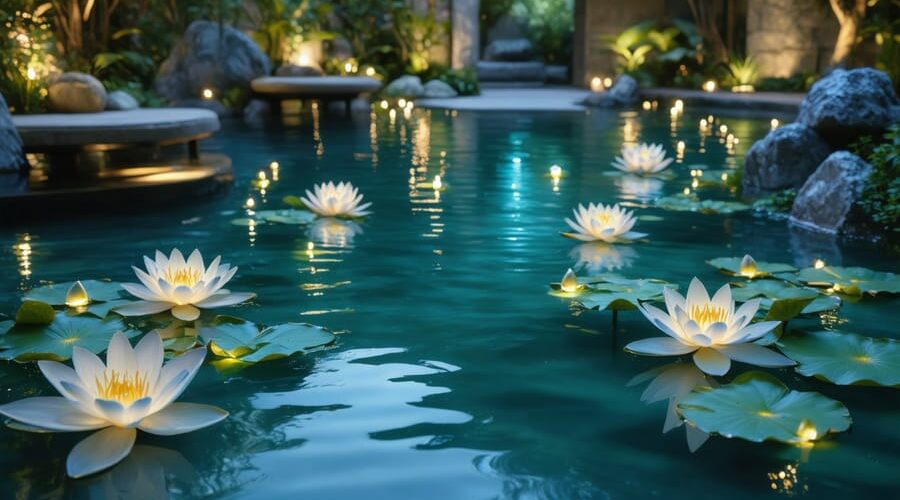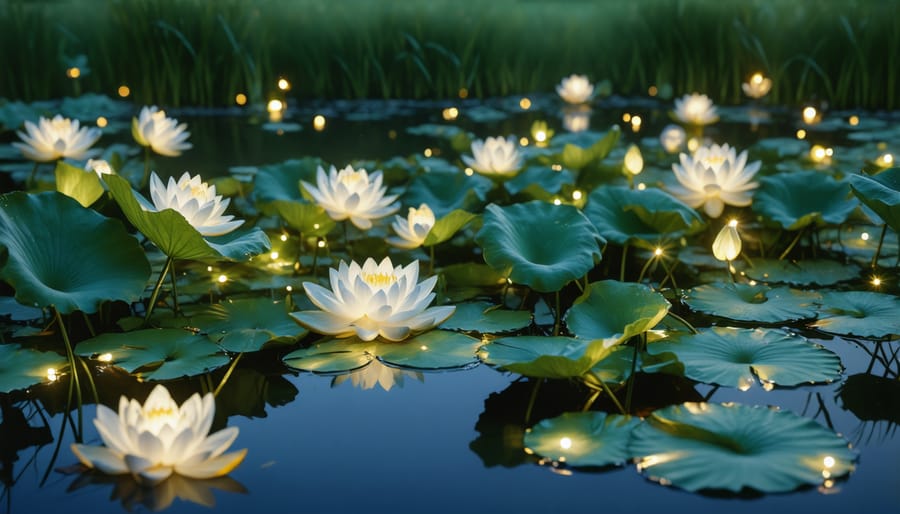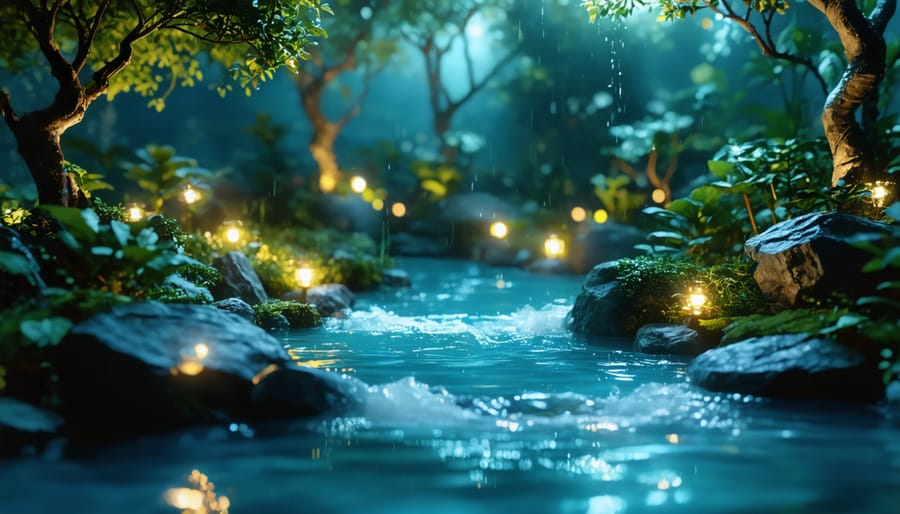
Transform Your Water Garden into a Magical Nighttime Oasis
Transform your water garden into a mesmerizing nighttime oasis with strategic lighting that brings life to rippling waters and aquatic plants after sunset. Underwater LED lights create shimmering effects beneath the surface, while carefully positioned spotlights highlight architectural features and showcase prized water lilies. The right lighting not only enhances security and safety around your water feature but also extends your enjoyment well into the evening hours.
Professional water garden designers understand that successful lighting combines three essential elements: function, drama, and energy efficiency. Submersible fixtures illuminate depths and create mysterious shadows, while pathway lights guide visitors safely around the water’s edge. Modern solar-powered options offer sustainable solutions that automatically activate at dusk, requiring minimal maintenance while delivering maximum impact.
Whether you’re planning a new water garden or upgrading an existing one, thoughtful lighting design transforms your aquatic landscape into an enchanting evening retreat. From simple floating lights to sophisticated computerized systems, today’s water garden lighting options cater to every style and budget, creating magical moments that connect you with your outdoor space long after the sun sets.
Essential Lighting Elements for Water Gardens
Underwater Lighting Solutions
Transforming your water garden after dark starts with effective underwater landscape lighting. Submersible lights are the workhorses of pond illumination, creating magical effects that bring your water feature to life at night. These waterproof fixtures come in various styles, from compact spotlights to wide-angle flood lights, each serving a specific purpose in your aquatic display.
For the best results, place submersible lights at different depths. Position some near the bottom to illuminate deeper areas and create mysterious shadows, while others can sit closer to the surface to highlight floating plants and create shimmer effects. When lighting water features like fountains or waterfalls, install lights behind or beneath them to create dramatic backlighting that makes water droplets sparkle.
LED submersible lights are particularly effective because they’re energy-efficient and long-lasting. Many come with color-changing options, allowing you to switch up your garden’s atmosphere for different occasions. Remember to angle lights upward at about 45 degrees to avoid glare and consider using multiple smaller lights rather than one powerful beam for more natural-looking illumination.
Always ensure your underwater lights are properly rated for submersion and connected to a GFCI-protected circuit for safety. Position cables discreetly along rocks or plants, and consider using automatic timers to control when your lights turn on and off. With proper placement and selection, underwater lights can transform your water garden into an enchanting nighttime retreat.

Above-Water Feature Lighting
Illuminating the areas around your water garden creates a magical atmosphere while ensuring safe navigation of your outdoor space. When exploring best pond lighting options, don’t overlook the importance of above-water features that complement your underwater lighting.
Spotlights are perfect for highlighting tall plants, sculptures, or water features like fountains. Position them at the base of these elements, angling upward to create dramatic shadows and depth. For best results, use warm white LED spotlights that won’t overwhelm the natural ambiance of your garden.
Path lights serve both practical and aesthetic purposes, guiding visitors safely around your water garden while creating a welcoming atmosphere. Place them every 6-8 feet along walkways, ensuring they’re positioned slightly away from the path’s edge to prevent accidental contact.
For accent lighting, consider using well lights installed flush with the ground to illuminate low-growing plants or rock features. Solar-powered stake lights are another excellent option, as they’re easy to install and can be repositioned as your garden evolves.
Remember to layer your lighting by combining different fixtures at various heights. This creates visual interest and ensures proper illumination throughout your water garden. Start with essential pathway lighting, then add accent lights to highlight special features, working your way up to spotlights for larger elements.
Creating Depth and Drama with Light
Layering Light Techniques
Creating a stunning water garden display is all about layering different types of lights, much like painting with light. Start with your base layer using submersible lights to illuminate the depths of your pond. Position these lights to highlight underwater features and create mysterious shadows that dance on the water’s surface.
Add your middle layer with spotlights positioned at the water’s edge. Aim these lights at water features like fountains or waterfalls, creating dramatic effects as light catches the moving water. Remember to angle your lights slightly downward to reduce glare and maximize the visual impact.
For your top layer, incorporate ambient lighting around the perimeter of your water garden. Path lights, bollards, or deck lights not only provide safe navigation but also create a warm, inviting atmosphere. Consider placing lights behind plants to create silhouettes and add depth to your nighttime display.
Don’t forget about vertical elements! Use uplighting on tall plants or garden structures to draw the eye upward and create a sense of height. String lights or lanterns hung overhead can add a magical touch and tie all the layers together.
The key to successful layering is balance. Start with low-intensity lighting and gradually build up, ensuring each layer complements rather than competes with the others. Use dimmers where possible to adjust light levels for different occasions or seasons.
For the finishing touch, incorporate some floating lights or illuminated water plants to bridge the gap between your underwater and above-water lighting elements. This creates a cohesive look that transforms your water garden into an enchanting nighttime retreat.

Color and Temperature Considerations
When planning your water garden lighting, understanding light color effects and temperature is crucial for creating the perfect nighttime atmosphere. Warm white lights (2700-3000K) create a cozy, intimate feeling and work beautifully with natural stone features and wooden elements. They’re particularly effective at highlighting water lilies and other flowering plants, making their colors appear rich and vibrant.
Cool white lights (5000-6500K), on the other hand, create a moonlight effect that makes water appear crystal clear and gives your garden a more contemporary feel. These lights work especially well with modern water features and can make your water garden feel larger and more open at night.
The color of your lights also affects how fish and aquatic plants appear underwater. Warmer tones tend to enhance the reds and oranges of koi fish, while cooler temperatures bring out the silvery scales of other pond fish. Consider using different color temperatures in various areas of your water garden to create depth and visual interest.
Remember that water absorbs light differently than air, so you’ll need brighter lights underwater than you might expect. A good rule of thumb is to choose lights about 20% brighter than what you’d use for regular landscape lighting. Also, keep in mind that colored lights should be used sparingly – they’re great for special occasions but might become overwhelming for everyday use.
The time of year can also influence your lighting choices. Warmer lights can make your garden feel more inviting during cold months, while cooler lights can create a refreshing atmosphere during summer evenings.
Smart Lighting Technologies
Automated Lighting Systems
Gone are the days of manually switching your water garden lights on and off. Today’s automated lighting systems make it easier than ever to create stunning nighttime displays with minimal effort. The heart of these systems is the programmable timer, which lets you set specific on/off schedules to match your lifestyle and the seasons.
Smart controls take automation even further, allowing you to manage your water garden lighting right from your smartphone. You can adjust brightness levels, create dynamic lighting scenes, and even sync your lights with sunset and sunrise times. Some systems even integrate with voice assistants like Alexa or Google Home, making control as simple as saying “Turn on the pond lights.”
Many modern systems offer convenient features like automatic dimming, motion sensors, and weather-responsive settings. For example, you might program your lights to brighten gradually as dusk approaches, creating a natural transition from day to night. Motion sensors can trigger subtle lighting changes when someone approaches, adding both security and drama to your garden.
When choosing an automated system, consider starting with a basic programmable timer if you’re new to water garden lighting. As you become more comfortable, you can upgrade to smart controls that offer more sophisticated features. Remember to choose weather-resistant controllers and ensure all connections are properly sealed against moisture.

Energy-Efficient Solutions
When it comes to lighting your water garden, energy efficiency isn’t just good for the environment – it’s great for your wallet too! LED lights have revolutionized water garden lighting, offering incredible brightness while using up to 80% less energy than traditional halogen bulbs. These modern marvels also last much longer, often providing up to 50,000 hours of illumination before needing replacement.
Solar-powered lighting offers another excellent eco-friendly option. These fixtures harness the sun’s energy during the day and automatically illuminate your water garden at night. While they might cost a bit more upfront, solar lights eliminate electricity costs entirely and are incredibly easy to install since they don’t require any wiring.
For the best energy-efficient setup, consider combining both technologies. Use LED lights for areas where you need consistent, bright illumination, such as underwater features or main focal points. Then, complement these with solar lights along pathways or for accent lighting. Many solar lights now come with built-in sensors that automatically adjust brightness based on battery levels, ensuring your garden stays lit throughout the night.
Look for fixtures with timers or smart controls – these let you program lighting schedules and adjust brightness levels, further reducing energy consumption. Some modern systems even connect to your smartphone, allowing you to control your garden lighting from anywhere while monitoring energy usage.
Installation and Maintenance Tips
Safety Considerations
When installing lighting around your water garden, safety should always be your top priority. Water and electricity can be a dangerous combination, so proper installation and maintenance are crucial. Always use low-voltage lighting systems (12-24V) specifically designed for underwater or outdoor use, as these significantly reduce the risk of electrical accidents.
Make sure all electrical connections are properly sealed and weatherproofed using waterproof junction boxes and connectors. Install a Ground Fault Circuit Interrupter (GFCI) outlet, which automatically cuts power if it detects any irregularities in the electrical current. This simple device could prevent serious accidents.
Keep cables and wires well-organized and buried at least 6 inches underground in protective conduits. This not only looks neater but also protects the wiring from lawn equipment and curious animals. When positioning underwater lights, ensure they remain fully submerged to prevent overheating, as this can affect both the equipment’s longevity and the impact on pond ecosystems.
Regular maintenance checks are essential. Inspect your lighting system every few months for signs of wear, damage, or water intrusion. If you’re not confident about electrical installations, always consult a qualified electrician – it’s better to be safe than sorry. Remember to switch off the power before performing any maintenance work, and never attempt repairs while the system is energized.
Seasonal Maintenance
Keeping your water garden lighting in top condition requires regular maintenance throughout the year. During spring, start by gently cleaning all fixtures with a soft cloth to remove winter debris and mineral deposits. Check all electrical connections and replace any worn gaskets or seals to prevent water damage.
Summer maintenance focuses on preventing algae growth on underwater lights. Monthly cleaning with a gentle brush keeps fixtures bright and efficient. Trim back any overhanging plants that might block light fixtures, and adjust lighting angles to accommodate growing aquatic plants.
As autumn approaches, remove fallen leaves regularly to prevent them from settling on submerged lights. This is also the perfect time to replace any burnt-out bulbs before the darker winter months arrive. Consider adding timer adjustments to account for earlier sunsets.
Winter requires special attention, especially in regions with freezing temperatures. If you have floating lights, bring them indoors during severe weather. For permanent fixtures, ensure they’re rated for winter use and positioned below the freeze line. Some gardeners choose to reduce lighting hours during winter to conserve energy.
Throughout all seasons, regularly inspect cables for damage, especially after storms or garden maintenance activities. Keep spare bulbs and basic repair supplies on hand for quick fixes. Remember that proper seasonal maintenance not only extends the life of your lighting system but also ensures your water garden remains a stunning focal point year-round.
Transforming your water garden with thoughtful lighting can create a magical nighttime oasis that extends your enjoyment long after sunset. By incorporating a mix of submersible lights, floating fixtures, and strategically placed spotlights, you can highlight your favorite features while ensuring safe navigation around your pond. Remember to start with a clear plan, consider energy-efficient LED options, and experiment with different lighting angles to achieve the perfect ambiance. Whether you’re showcasing colorful koi, illuminating waterfalls, or creating subtle moonlight effects, proper lighting brings your water garden to life in exciting new ways. Don’t be afraid to get creative and adjust your lighting scheme seasonally. With these lighting techniques at your disposal, you’re well-equipped to transform your water garden into an enchanting nighttime retreat that you and your guests will cherish for years to come.
